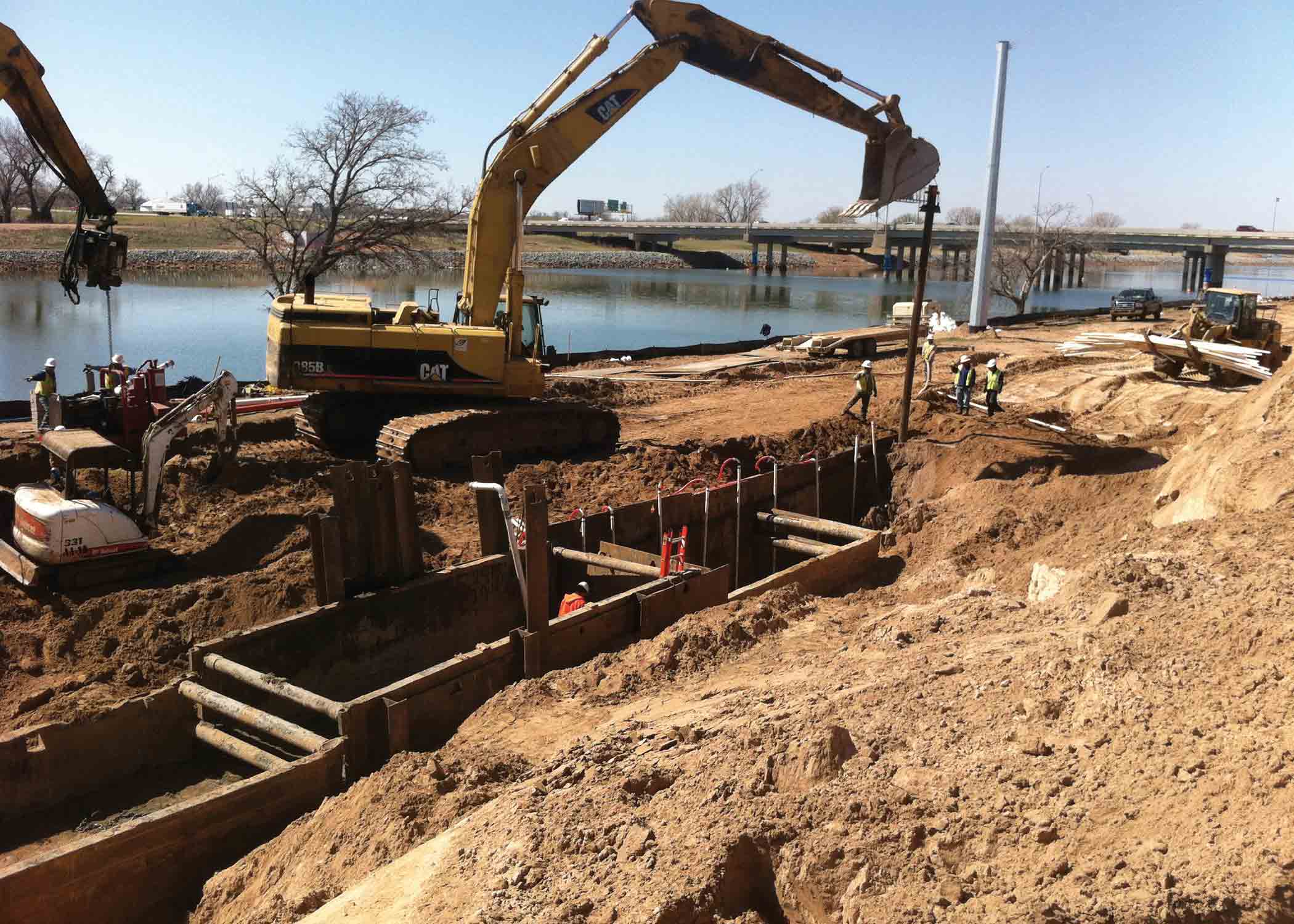
HOBAS GRP Culvert Under the Oklahoma River
In Oklahoma City, HOBAS GRP Pipes in various diameters were successfully installed in open trench under challenging conditions.
With 1,600 km² and more than 1.2 million inhabitants, Oklahoma City is the most highly populated city in the state of Oklahoma. The waterway which flows through the City and is now known as “Oklahoma River” was long thought of as little more than a drainage ditch. But all that was changed by the Metropolitan Area Projects (MAPS), a bundle of nine major Oklahoma City projects which was enacted in December 2013. Under the provision of MAPS, an 11 km stretch of the North Canadian River that flows just south of downtown was transformed and renamed “The Oklahoma River” in 2004. Apart from recreational trails and dams to raise the water levels, the developments also included the € 4.5 million project “Oklahoma River Inverted Siphon System Improvements, Phase II”.
The project involved the rehabilitation of an existing inverted siphon, a new inverted siphon, and a sewer line connecting the new inverted siphon to the collection system. The existing siphon had inadequate capacity to handle flows during wet weather events. The project should facilitate the transport of sewage from South Oklahoma City to the North Canadian Wastewater Treatment Plant and help reduce sanitary sewer overflows at the watersheds of two creeks nearby.
HOBAS Pipe USA custom-manufactured centrifugally cast, glass fiber reinforced pipes for this project. The new inverted siphon consisting of 179 m each of GRP pipes DN 600 and 1200 was installed under the Oklahoma River by use of a dam, which temporarily retained the water. In addition, 762 m of sanitary sewer main DN 1800 were installed by direct bury. “The smaller pipes generate flow velocities high enough to scour sludge buildup. The DN 1800 pipes are on the other hand fine for the normal flow rates”, explains E. O‘Neil Robinson from Cardinal Engineering. HOBAS Pipe USA also designed and manufactured the 45-degree GRP elbows that were needed to take the flow from the DN 1800 line into the smaller siphons and feed it into the DN 1800 line on the other side of the river. The existing siphon, consisting of pipes DN 600, 700 and 1000 was cleaned and inspected to determine if it needed to be rehabilitated.
Installation challenges and solutions
Access to the north side of the river with equipment and materials was difficult as it is confined by two major highways. Together with the Oklahoma Department of Transportation, the client developed a plan for a temporary access to coordinate entry and exit from the highways right-of-way. The biggest challenges of the siphon installation were the depth of 9 m in some areas as well as the difficult soil conditions: coarse sand and ground water were about 3 m above the pipe. “It was a challenge to shore the area and keep the trench dry,” said Bill Geiser from Lewis Contractors. As the pipe was laid and joints connected, it was encased in reinforced concrete to prevent flotation and covered with rip-rap. Also, this section of the river is periodically dredged, so the concrete would act as a barrier in case contact was made with the dredging equipment.
The schedule for the siphon installation was time-sensitive due to the traffic on the Oklahoma River. This particular section of the river is the site of the Oklahoma City Boathouse District, which includes rowing clubs. “We only had about 60 days to construct the new siphons. Since we had to lower the water level for construction, we had an agreement with the City that the water level would be raised to the appropriate level for the planned rowing events,” stated Robinson. Despite these organizational challenges and a four-week rain delay, the contractor Lewis Contractors finished the project on time.
Construction Benefits
“We choose to specify GRP in the design because we felt very comfortable using the product and it was appropriate for this project due to the construction technique chosen and the time constraints imposed,” said Robinson. The HOBAS Pipes’ light weight led to a faster installation thanks to the ease of handling and the use of lighter equipment. In addition to the added capacity, the new siphon allows for easier and safer maintenance of both the existing and the new siphon. The whole project was successfully completed and is now in service.
More information about this application
PROJECT DETAILS
| Project ID: [6516] | |
| Country: | United States of America |
| City: | Oklahoma City |
| Year: | 2013 |
| Application: | Sewer |
| Installation: | Open Trench |
| Technology: | Hobas |
| Total Length: | 1120 m |
| Nominal Diameter DN: | 600 | 1200 | 1800 mm |
| Nominal Pressure PN: | 2 bar |
| Nominal Stiffness SN: | 10000 N/m2 |
